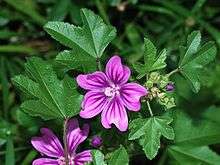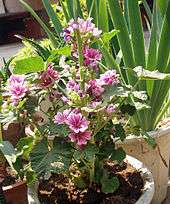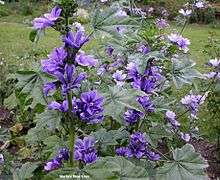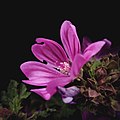Malva sylvestris
Malva sylvestris is a species of the mallow genus Malva in the family of Malvaceae and is considered to be the type species for the genus. Known as common mallow to English-speaking Europeans,[3] it acquired the common names of cheeses, high mallow and tall mallow (mauve des bois by the French)[4] as it migrated from its native home in Western Europe, North Africa and Asia through the English-speaking world.[5]
| Malva sylvestris | |
|---|---|
 | |
| Type species for Malva L. | |
| Scientific classification | |
| Kingdom: | Plantae |
| Clade: | Tracheophytes |
| Clade: | Angiosperms |
| Clade: | Eudicots |
| Clade: | Rosids |
| Order: | Malvales |
| Family: | Malvaceae |
| Genus: | Malva |
| Species: | M. sylvestris |
| Binomial name | |
| Malva sylvestris | |
| Synonyms [1][2] | |
| |
M. sylvestris is a vigorous plant with showy flowers of bright mauve-purple, with dark veins, standing 3–4 feet (0.91–1.22 m) high and growing freely in meadows, hedgerows and in fallow fields.[6]
Common names
It is one of several species of different genera sometimes referred to as Creeping Charlie, a term more commonly applied to Glechoma hederacea (ground ivy).[7]
Description
Malva sylvestris is a spreading[3] herb,[8] which is an annual in North Africa,[9] biennial[5][10] in the Mediterranean[9] and a perennial elsewhere.[9][8] It can be straight or decumbent,[3][8] branched, and covered with fine soft hairs or none at all,[10] M. sylvestris is pleasing in appearance when it first starts to flower, but as the summer advances, "the leaves lose their deep green color and the stems assume a ragged appearance".[6]
Leaves
The leaves are borne upon the stem, are roundish, with numerous lobes, each 2–4 centimetres (0.79–1.57 in) long, 2–5 centimetres (0.79–1.97 in) and 5–10 centimetres (2.0–3.9 in) in diameter.[8] The leaves have hairs radiating from a common center, with prominent veins on the underside.[6]
Flowers
.jpg)
Described as reddish-purple,[10] bright pinkish-purple with dark stripes[3] and bright mauve-purple,[6] the flowers of Malva sylvestris appear in axillary clusters[8] of 2 to 4[5] and form irregularly and elongated along the main stem with the flowers at the base opening first.[8]
M. sylvestris has an epicalyx (or false calyx) with oblong segments, two-thirds as long as calyx[8] or 2–3 millimeters long and 1.5 millimeters wide.[5] Its calyx is free to the middle, 3–6 millimeters long,[5] with broadly triangular lobes[5] or ovate mostly 5–7 millimeters long.[8] The flowers are 2–4 times as long as the calyx;[10]
Fruits
Nutlets strongly reticulate (10–12 mericarps, usually without hair, with sharp angle between dorsal and lateral surfaces, 5–6 mm in diameter.[3][5]
Seeds
Also called 'cheeses,'[6] seeds are brown to brownish green when ripe, about 2.5 millimeters long and wide[5][8] 5 to 7 millimeters in diameter[8] and are shaped like a cheese wheel.
Distribution
Malva sylvestris spreads itself on waste and rough ground, by roads and railways throughout lowland England, Wales and Channel Islands, Siberia and scattered elsewhere.[3][10] It has been introduced to and has become naturalised in eastern Australia,[8] in the United States, Canada, and Mexico as an invasive species.[10]
In the wild
- Palearctic:
- Macaronesia: Azores, Madeira Islands
- Northern Africa: Algeria, Egypt, Libya, Morocco
- Arabian Peninsula: Saudi Arabia
- Western Asia: Afghanistan, Sinai, Iran, Israel, Jordan, Lebanon, Syria, Turkey
- Caucasus: Armenia, Azerbaijan, Ciscaucasia, Dagestan, Georgia
- Soviet Middle Asia: Kyrgyzstan, Tajikistan, Turkmenistan, Uzbekistan
- Mongolia: Mongolia
- China: Xinjiang
- Indian Subcontinent: Bhutan, India, Pakistan
- Northern Europe: Denmark, Finland, Ireland, Norway, Sweden, United Kingdom
- Middle Europe: Austria, Belgium, Czech Republic, Germany, Hungary, Netherlands, Poland, Slovakia, Switzerland
- East Europe: Belarus, Central Russia, Central Black Earth, Estonia, Latvia, Lithuania, Moldova, Northern Russia, North Caucasus, Northwestern Russia, Volga, Urals, Volga-Vyatka, Ukraine
- Southeastern Europe: Albania, Bosnia and Herzegovina, Bulgaria, Croatia, Greece, Italy, Macedonia, Montenegro, Sardinia, Serbia, Sicily, Slovenia, Romania, Cyprus
- Southwestern Europe: Balearic Islands, Corsica, France, Portugal, Spain
Source: USDA ARS GRIN[4]
Uses

In 1931, Maud Grieve wrote that the "use of this species of Mallow has been much superseded by marsh-mallow (Althaea officinalis), which possesses its properties in a superior degree, but it is still a favorite remedy with country people where marsh-mallow is not obtainable."[6] The flowers were spread on doorways and woven into garlands or chaplets for celebrating May Day.[6] The boiled young leaves are a vegetable eaten in several parts of Europe in the 19th century.[11]
In Morocco, Tunisia and Palestine, Malva leaves are steamed with garlic and tomatoes, and eaten as an appetizer or salad.[12] In Egypt, the leaves are made into a stew-like vegetable dish, especially in winter, known as khobeiza, which is similar to Molokheia.[13]
In traditional medicine, M. sylvestris has been used in herbalism. Mucilage is present in many of the family Malvaceae including M. sylvestris,[14][15] especially the fruit.[16] The seeds are used internally in a decoction or herbal tea as a demulcent,[11] and the leaves may be used in poultices as an emollient for external applications.[16]
The species has long been used as a natural yellow dye,[17] but dyes of various yellow-green colors can be obtained from the plant and its seeds.[18] A tincture of the flowers can make a sensitive test for alkalis.[6]
Subspecies
Plants previously often described as Malva sylvestris var. malaca are now considered a cultivar group Malva sylvestris Mauritiana Group.[9]
Cultivation

It is often grown as an ornamental plant for its attractive flowers, produced for a long period through the summer. Numerous cultivars have been selected and named.
Cultivars of Malva sylvestris include: 'Annita', 'Aurora', 'Bardsey Blue', 'Blue Fountain', 'Brave Heart', 'Cottenham Blue', 'Gibbortello', 'Harry Hay', 'Highnam', 'Inky Stripe', 'Knockout', 'Magic Hollyhock', 'Mest', 'Mystic Merlin', 'Perry's Blue', 'Purple Satin', 'Richard Perry', 'Tournai', 'Windsor Castle', 'Zebrina' (soft lavender-purple striped with deep maroon veins) [19] and 'Zebrina Zebra Magis'.
Cultivar groups

- Malva sylvestris L. Mauritiana group: Swedish: mauretansk rödmalva, Estonian: mauri kassinaeris, Slovene: Mavretanski slezenovec, Hungarian: mórmályva. Malva mauritiana used to be recognized as a species whose range is Iberia, Italy and Algeria. Garden plants are often called Malva sylvestris var. mauritiana and they make a cultivar group that includes:
- 'Bibor Felho'
- 'Moravia'
- Malva sylvestris L. Eriocarpa group: Hairy seeds and hairy stems found between Italy and the Himalayas, Central Asia and China.
- Malva sylvestris L. Canescens group: Every part except for the flower is covered with dense white woolly hair, growing in the Montpellier region of France, and on the Balearic Isles. Some 19th-century botanical works called this group Malva sylvestris L. var. canescens.
- Malva sylvestris L. Sterile Blue group: Vegetatively propagated pale violet-blue flowered cultivars:
- Marina 'Dema'
- 'Primley Blue'
- 'Maria's Blue Eyes' (dark violet-blue flowered)
Virus
Malva vein clearing potyvirus which is transmitted by mechanical inoculation in a non-persistent manner via insects, such as Aphis umbrella (syn. Aphis malvae Koch) and Myzus persicae (all are Aphididae). The virus can be found in Tasmania, Brazil, the former Czechoslovakia, Germany, Israel, Italy, Portugal, California, Russia and the former Yugoslavia.[20][21]
Chemistry
M. sylvestris contains malvin and malonylmalvin.[22] It also contains the naphthoquinone malvone A, which is also a phytoalaxin.[23]
Gallery
 Fruit
Fruit Ripe nutlets
Ripe nutlets Firebug on fruit of Malva sylvestris
Firebug on fruit of Malva sylvestris A flower of a common mallow
A flower of a common mallow Common mallow closeup
Common mallow closeup
References
- "Flora Europaea Search Results". Flora Europaea. Royal Botanic Garden Edinburgh. Retrieved 9 May 2008.
- "Malva sylvestris L. record n° 81830". African Plants Database. South African National Biodiversity Institute, the Conservatoire et Jardin botaniques de la Ville de Genève and Tela Botanica. Archived from the original on 1 January 2013. Retrieved 9 May 2008.
- C. Stace. R. van der Meijden; I. de Kort (eds.). "Malva sylvestris (Mallow, Common)". Interactive Flora of NW Europe. Netherlands Biodiversity Information Facility. Retrieved 9 May 2008.
- Germplasm Resources Information Network (GRIN) (20 May 1992). "Taxon: Malva sylvestris L." Taxonomy for Plants. USDA, ARS, National Genetic Resources Program, National Germplasm Resources Laboratory, Beltsville, Maryland. Retrieved 9 May 2008.
- Flora of Pakistan. "Malva sylvestris Linn". Retrieved 9 May 2008. Cite journal requires
|journal=(help) - M. Grieve (1931). "MALLOW, BLUE". A Modern Herbal. Botanical.com.
- Sinclair, Pam (7 October 1999). "creeping charlie". Plantbio mailing list (Mailing list). Retrieved 10 May 2008.
- National Herbarium of New South Wales. "Search PlantNET". New South Wales FloraOnline. Royal Botanic Gardens, Sydney. Retrieved 9 May 2008.
- Stewart Robert Hinsley. "Malva sylvestris (section Malva, in part)". The Malva Pages. Archived from the original on 3 July 2013. Retrieved 9 May 2008.
- Britton, Nathaniel; Addison Brown (1913). "CYRILLACEAE". An illustrated flora of the northern United States, Canada and the British possessions. Volume II, Amaranthaceae to Loganiaceae. Charles Scribner's Sons. pp. 2052 pages. Retrieved 10 May 2008.
- Hiley, John S. (1841). "On the medical botany of the province of Halifax". In Thomas Wakley (ed.). The Lancet, In Two Volumes (Volume The Second ed.). J. Onwhyn. Retrieved 10 May 2008.
- "Khobiza Recipe (Fr)".
- "Khobeiza recipe".
- Balfour, John Hutton (1863). "Products and Secretions of Plants". A manual of botany: being an introduction to the study of the structure, physiology, and classification of plants. Edinburgh: A & C Black. Retrieved 10 May 2008.
- Balfour, John Hutton (1863). "Malvaceae". A manual of botany: being an introduction to the study of the structure, physiology, and classification of plants. Edinburgh: A & C Black. Retrieved 10 May 2008.
- Dey, William Mair, Kanny Lall; Mair, William (1896). "Indigenous Drugs of India". The indigenous drugs of India: short descriptive notices of the principal medicinal products met with in British India. Thacker, Spink & Co. pp. 387 pages. Retrieved 10 May 2008.
- Bailey, Liberty Hyde (1910). "Dyes and Dyeing. C.S. Doggert". Cyclopedia of American agriculture: a popular survey of agricultural conditions, practices and ideals in the United States and Canada, In Four Volumes. Volume II --Crops. Macmillan Publishers. pp. 2016 pages. Retrieved 10 May 2008.
- "Malva sylvestris L." Plants for a Future. Retrieved 10 May 2008.
- Heritage Perennials: Malva sylvestris 'Zebrina'
- "00.057.0.81.049. Malva vein clearing virus". ICTVdB Management. Columbia University. 2006. Retrieved 10 May 2008.
- Brunt, A.A.; Crabtree, K.; Dallwitz, M.J.; Gibbs, A.J.; Watson, L.; Zurcher, E.J., eds. (August 1996). "Descriptions and Lists from the VIDE Database: Malva vein clearing potyvirus". Plant Viruses Online. University of Idaho. Archived from the original on 11 May 2008. Retrieved 10 May 2008.
- Malonated anthocyanins in malvaceae: Malonylmalvin from Malva sylvestris. Kosaku Takeda, Shigeki Enoki, Jeffrey B. Harborne and John Eagles, Phytochemistry, 1989, Volume 28, Issue 2, pp. 499–500, doi:10.1016/0031-9422(89)80040-8
- Malvone A, a phytoalexin found in Malva sylvestris (family Malvaceae).Olga Veshkurova, Zamira Golubenko, Egor Pshenichnov, Irina Arzanova, Vyacheslav Uzbekov, Elvira Sultanova, Shavkat Salikhov, Howard J. Williams, Joseph H. Reibenspies, Lorraine S. Puckhaber and Robert D. Stipanovic, Phytochemistry, November 2006, Volume 67, Issue 21, pp. 2376–2379, doi:10.1016/j.phytochem.2006.08.010
External links


- UniProt. "Malva sylvestris". Retrieved 10 May 2008.